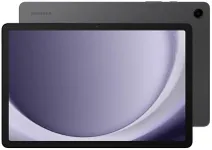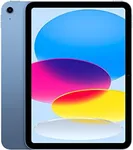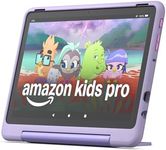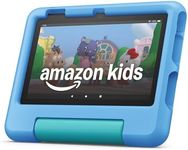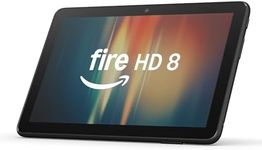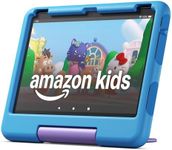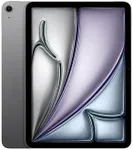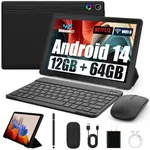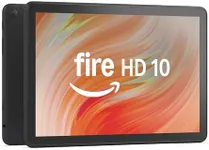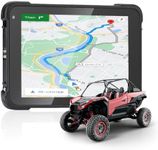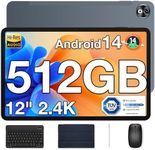Buying Guide for the Best Tablet
Choosing the right tablet can greatly enhance your digital experience, whether it's for work, entertainment, or education. To make an informed decision, it's important to understand the key specifications and how they align with your needs. Here are the main specs to consider when selecting a tablet, along with explanations to help you navigate through them.Display SizeThe display size of a tablet is measured diagonally in inches and determines how large the screen is. This spec is important because it affects the portability and usability of the device. Smaller tablets (7-8 inches) are more portable and easier to hold with one hand, making them ideal for reading and casual browsing. Medium-sized tablets (9-10 inches) offer a balance between portability and screen real estate, suitable for watching videos and light productivity tasks. Larger tablets (11 inches and above) provide a more immersive experience and are better for multitasking and professional use. Choose a size that fits your primary use case and comfort.
ResolutionResolution refers to the number of pixels on the screen and is usually denoted as width x height (e.g., 1920x1080). Higher resolution means sharper and clearer images. This spec is important for activities like watching videos, reading, and graphic design. Standard resolution (around 1280x800) is sufficient for basic tasks. Full HD (1920x1080) offers better clarity for media consumption. Higher resolutions like 2K or 4K are ideal for professional work and high-quality media viewing. Consider your visual needs and how much detail you require in your display.
ProcessorThe processor, or CPU, is the brain of the tablet and determines how fast and efficiently it can run applications. This spec is crucial for overall performance. Entry-level processors are suitable for basic tasks like browsing and reading. Mid-range processors handle multitasking and media consumption well. High-end processors are designed for demanding tasks such as gaming, video editing, and professional applications. Think about the types of activities you'll be doing on your tablet and choose a processor that can handle them smoothly.
RAMRAM (Random Access Memory) affects how well a tablet can handle multitasking and run applications smoothly. More RAM allows for better performance, especially when running multiple apps simultaneously. Tablets with 2-3GB of RAM are adequate for basic use. 4-6GB of RAM is suitable for moderate multitasking and more demanding apps. Tablets with 8GB or more are ideal for heavy multitasking, gaming, and professional use. Consider how many apps you typically use at once and choose a tablet with enough RAM to keep things running smoothly.
StorageStorage capacity determines how much data you can store on your tablet, including apps, photos, videos, and documents. This spec is important for managing your files and media. Tablets with 32GB of storage are suitable for light use and cloud storage reliance. 64-128GB is a good middle ground for most users, providing ample space for apps and media. Tablets with 256GB or more are ideal for heavy media consumption, large app libraries, and professional use. Think about your storage needs and whether you prefer to store data locally or use cloud services.
Battery LifeBattery life indicates how long a tablet can run on a single charge and is usually measured in hours. This spec is important for portability and convenience, especially if you use your tablet on the go. Tablets with 6-8 hours of battery life are suitable for casual use. 8-10 hours provide a good balance for most users, allowing for a full day of use. Tablets with 10+ hours of battery life are ideal for heavy use and travel. Consider how often you'll be using your tablet away from a power source and choose one with sufficient battery life to meet your needs.
Operating SystemThe operating system (OS) determines the user interface and available apps for your tablet. The main options are iOS (Apple), Android, and Windows. iOS offers a smooth, user-friendly experience with a wide range of high-quality apps, ideal for users who prefer a seamless ecosystem. Android provides more customization options and a variety of devices, suitable for users who like flexibility. Windows tablets are great for productivity and compatibility with desktop applications, ideal for professional use. Choose an OS that aligns with your preferences and the type of apps you need.
ConnectivityConnectivity options include Wi-Fi, cellular (4G/5G), Bluetooth, and various ports (USB, HDMI). This spec is important for how you plan to use your tablet. Wi-Fi-only tablets are sufficient for home use and places with reliable internet access. Tablets with cellular connectivity are ideal for on-the-go use, allowing you to stay connected without relying on Wi-Fi. Bluetooth is essential for connecting peripherals like keyboards and headphones. Consider your connectivity needs and choose a tablet that offers the necessary options for your lifestyle.
Camera QualityCamera quality is measured in megapixels (MP) and affects the clarity of photos and videos. This spec is important for users who plan to take photos, video chat, or use the tablet for creative work. Basic cameras (5-8MP) are sufficient for casual photos and video calls. Mid-range cameras (8-12MP) offer better quality for more detailed photos and videos. High-end cameras (12MP and above) are ideal for professional photography and videography. Consider how often you'll use the camera and for what purposes, and choose a tablet with a camera that meets your needs.
